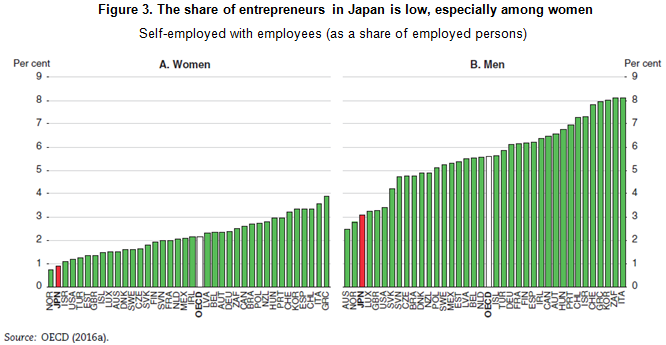Japan needs policies to boost productivity for inclusive growth
by Randall Jones, Head of Japan Desk, OECD Economics Department
Labour productivity in Japan is about a quarter below the average of the top half of OECD countries (Figure 1), which is surprising given Japan’s outstanding performance in education and skills and high level of R&D spending. As in other countries, the labour productivity gap between leading and lagging firms has widened in Japan, resulting in greater wage inequality between firms. The 2017 OECD Economic Survey of Japan examines the scope for positive synergy between policies to promote productivity and inclusive growth.

The Survey stresses the importance of facilitating the exit of non-viable firms and the entry of innovative start-ups to narrow inter-firm productivity and wage gaps. Japan’s low exit rate, which is only about half of that in other advanced countries (Figure 2), results in a large number of non-viable firms. The widespread use of personal guarantees and the stringency of the personal insolvency regime are important impediments to firm exit. Japan’s growth strategy set a goal of raising both the exit and entry rates to around 10%. Of course, increased exit of non-viable firms would raise the number of displaced workers, making it important to promote their re-employment.

Japan’s firm entry rate is also well below other advanced economies (Figure 2, Panel B). Consequently, firms more than ten years old account for three-quarters of Japan’s small enterprises compared to less than half in most OECD countries. The Survey identifies weak entrepreneurship in Japan as a major reason for the low entry rate. Indeed, the number of entrepreneurs in Japan is among the lowest in the OECD (Figure 3). Increasing entrepreneurship requires improving its image; less than a third of Japan’s working-age population views entrepreneurship as a good career choice, the lowest in the OECD. The negative perception in Japan reflects a lack of perceived opportunities (7%, the lowest in the OECD), perceived capabilities (12%, the lowest) and a fear of failure (55%, the second highest).

The main messages of this Survey on the nexus between productivity and inclusive growth are:
- The dispersion in productivity and labour income between firms is relatively large in Japan and has been widening.
- The firm entry and exit rates in Japan are well below other advanced economies and the number of entrepreneurs is low.
- Policies to facilitate the exit of non-viable firms and to increase the entry of innovative new firms are a priority to boost productivity and promote inclusive growth.
References
Ministry of Economy, Trade and Industry (2014), 2014 White Paper on Small and Medium Enterprises in Japan, Tokyo.
OECD (2016b), Entrepreneurship at a Glance, OECD Publishing, Paris.
OECD (2017a), OECD Economic Outlook: Statistics and Projections (database).OECD, Paris.
OECD (2017), OECD Economic Surveys: Japan, OECD Publishing, Paris.